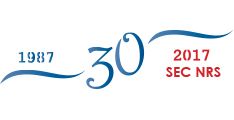19.12.2019
On December 19, 2019, SEC NRS hosted the scheduled meeting of the Presidium of Rostechnadzor Expert Council on Validation of Computer Codes, where the issues on certification of the following computer codes were considered:
- “Risk Version 2.0 with Risk-monitor graph unit” designed for calculation of probabilistic safety indexes in the process of Levels 1 and 2 Probabilistic Safety Analyses for nuclear facilities;
- “Risk Spectrum PSA” designed for probabilistic analysis of risk and reliability of nuclear installations using the method of fault trees and event trees;
- “PTC WindChill Quality Solutions” (Version 11.0) designed for evaluation of the reliability of complex process items, equipment and systems, including nuclear facilities and other hazardous industrial facilities;
- “ABAQUS” in the part of calculations of the stress-strain behavior, self-frequencies and vibration modes, robustness of the equipment and building structures (including metal-concrete reactor vessels) under static and dynamic loads with the account of physically and geometrically nonlinear material response;
- “Prognoz_Р 1.0” (updated version) in the part of calculation of probability for VVER reactor vessel destruction under normal operation, as well as in emergencies, leading to pressure vessel heat shock;
- “APM Structure3D” (Version 16) in the part of calculation of the stress-strain behavior of a nuclear facility equipment and structures under static and time-varying loading, static stability, free vibration frequencies and modes;
- “LOGOS-Prochnost” in the part of simulation of the stress-strain behavior and analysis of the dynamic, quasi-static and vibration strength of the elements of nuclear facilities’ reactor cores, equipment and systems under aggregate thermomechanical effects;
- “ROUZ” designed for evaluation of the radiation situation, being formed or formed as a result of effect of the stationary source of radioactive substances emissions into atmosphere and aggregate thereof (nuclear facilities and industrial facilities) with the account of effect from the industrial or urban area (real-life 3D geometry);
- “HYDRA-K” designed for simulation of steady-state and non-steady-state thermal processes in the elements of a nuclear facility vessel structures and building structures with the account of associated goal setting for heat-removal and hydraulics (in respect to the reactor installation BREST-OD-300);
- “FlowVision” in the part of simulation of thermal hydraulic processes under the flow of primary sodium in BN reactor installation. The computer code ensures simulation of the turbulent and stream-line flows of primary sodium under forced, mixed and natural convection to solve the tasks of the computational fluid dynamics (turbulent heat-transfer model LMS);
- “LOGOS-Teplo” in the part of simulation of heat conductivity processes and assessment of temperature fields in shipping packaging sets and equipment components of reactor installations with the account of energy release and radiation heat transfer;
- “KORTES/V1” in the part of simulation of thermal hydraulic processes in VVER NPP equipment and process systems, except for reactor core and reactor coolant circuit of the reactor installation;
- “ANSYS FLUENT” in the part of simulation of steady-state forced flows accompanied by heat transfer from the liquid-metal coolant in fuel assemblies of fast neutron reactors equipped with smooth fuel rods and spacer grids;
- “SAPPHIRE_95&RC_micro” designed for fuel rod-by-fuel rod 3D steady-state calculations of power distribution in VVER reactor core in 6-group diffusion approximation;
- “ODETTA” designed for calculation of the forthcoming functionals of the neutron flux density spatial-energy distribution under specified radiation sources.
Positive decisions were provided for all the computer codes, confirming the possibility for certification thereof; moreover, comments and recommendations were given to be taken into account in the process of final issuing of the certificates for the above-mentioned computer codes.
For reference:
Rostechnadzor Order No. 450 of 20.09.2018 states, that SEC NRS carries out the activity on the review of computer codes.
The Expert Council on Validation of Computer Codes was founded under the auspices of Rostechnadzor for the purpose of implementation of the Article 8 “Procedure for Conduct of the Review of Computer Codes, Applied to Build Simulation Models for Processes Affecting Safety of Nuclear Facilities and (or) Types of Activities in the Field of Atomic Energy Use” approved by the Order of Rostechnadzor No. 325 dated of 30.07.2018 (registered in the Ministry of Justice of Russia on 12.11.2018 under the No. 52650).
“Provisions on the Expert Council” approved by the Order of Rostechnadzor No. 655 dated of 27.12.2018. The major tasks for the Expert Council are the evaluation of the results of review of computer codes, as well as giving proposals on the content of the draft certificates for computer codes.
The Presidium of Rostechnadzor Expert Council on Validation of Computer Codes includes the representatives from Rostechnadzor, SEC NRS, JSC ATOMPROEKT, JSC “Atomenergoproject”, JSC VNIIAES, JSC VNIINM, JSC “SSC RIAR”, JSC “SSC RF – IPPE”, JSC “CONCERN ROSENERGOATOM”, JSC “NIKIET”, JSC “Afrikantov OKBM”, JSC “EREC”, JSC ASE EC, OKB “GIDROPRESS”, IBRAE RAS, NRC “Kurchatov Institute”, NRNU MEPhI, SEC “Energy Safety”, FSUE “Alexandrov NITI”, FSUE “RosRAO”, FSUE “RFNC-VNIITF”, SUE «RFNC-VNIIEF».

